
[edited to add:
Rivendell Bicycle Works was a sponsor of this website in May - June . This post was written prior to that time.]
I have owned my
Rivendell Sam Hillborne("Graham Greene") for 6 months now, and have ridden it for 1,800 miles. It is time for a review. The short version is: "I love it. I love it
so much!" For the long version, read on.

I received a
Rivendell Sam Hillborne frame as a holiday gift in December , purchased from
Harris Cycleryin West Newton, MA. We were not yet comfortable building up a bike on our own, so the build was done at
Harris as well. It took me a few months to save up for the components, and the bicycle was ready in the end of April.Note that
Harris Cyclerywas not a sponsor at the time, and that everything in relation to this bicycle was a standard purchase.

My choice of build for the
Hillborne was informed by test-riding a floor model in my size. Since I had no real experience riding a roadbike at that point, I mostly went with recommended specs. These included a 3x8 drivetrain,
Sugino cranks,
Nitto Noodle handlebars with
Silver bar-end shifters, and a
Brooks B17S saddle. My 52cm frame was built for 650B wheels and cantilever brakes.
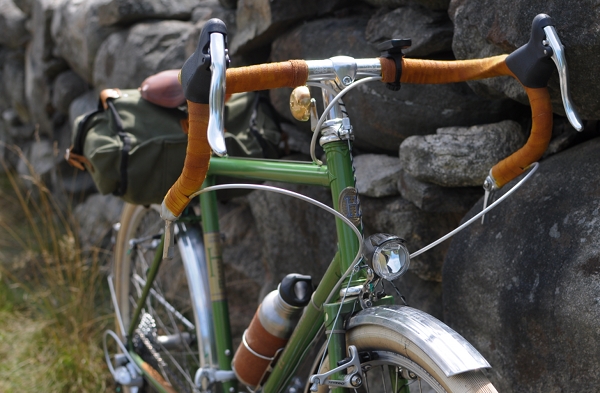
The three things I specifically chose for this bicycle were handbuilt wheels with dynamo lighting (see details here),
Grand Bois Hetre tires (see review here), and
Tektro short reach brake levers. The discovery of these brake levers was crucial for me. One thing that had hitherto prevented me from riding bicycles with drop bars, was my inability to squeeze the brake levers - especially from the hoods. I have small hands
and I have damaged nerves in my hands. The combination made squeezing this type of lever impossible. When I described the problem to Elton at
Harris Cyclery, we went through different brake levers to see whether any existed that I
was able to squeeze. The
Tektro levers were
it and I am extremely happy with them. Elton also showed me some methods of hand and finger placement that work well for me and do not send electric currents through my fingers. I cannot stress enough what a break-through this was in terms of understanding why I was having problems riding with drop bars before.
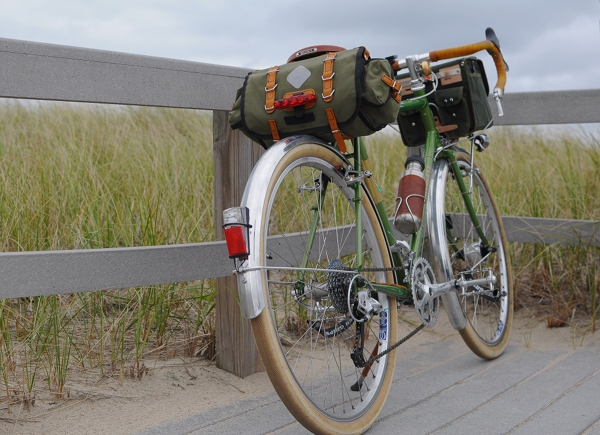
Over time, I added other personal touches to the bicycle. These include a
Carradice saddle bag,

a
Nitto M-18 front rack from
Renaissance Bicycle (a sponsor), an
Ostrich handlebag bag from
Velo Orangewhich I use on long trips,
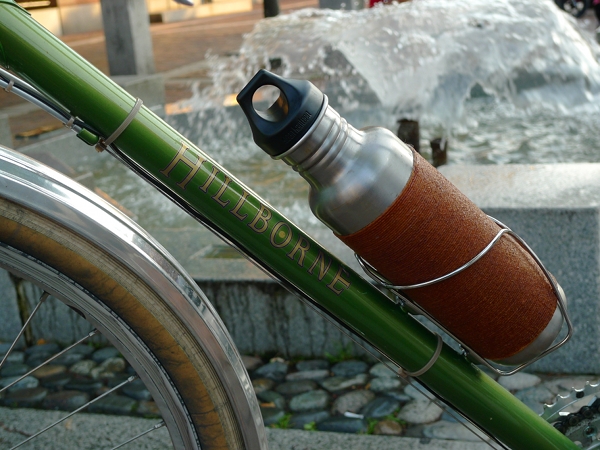
a twined and shellacked
Klean Kanteen water bottle,

and my beloved
Power Grips (see here for my initial review of them).
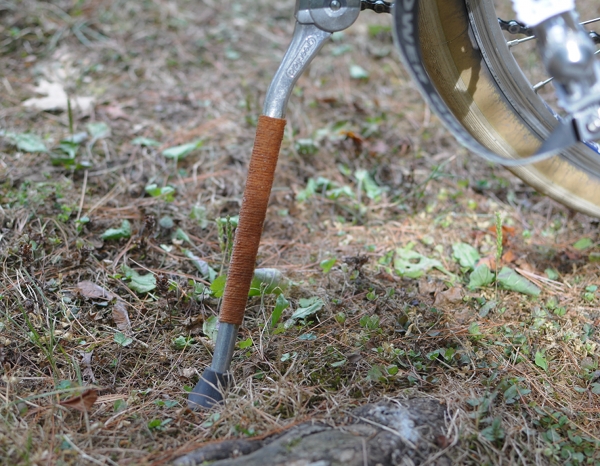
I have also twined and shellacked the kickstand (to prevent it from scraping against the pedal when the bike is parked),
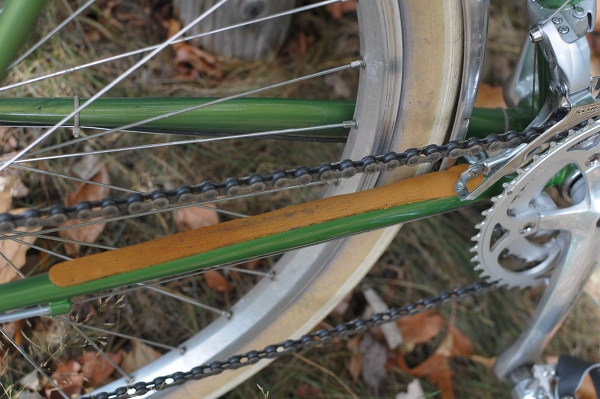
and added a leather
Velo Orangechainstay protector. This product is great for preventing the paint on the right chainstay from getting nicked by the chain slapping against it when the bicycle goes over bumps - which began to happen to my
Rivendell within the first few rides I went on.

There are a few additional little details that I enjoy, but no one else probably notices - like these green cable endcap crimps,

and the "taupe" zipties (see top right, under the waterbottle) for routing the dynamo lighting that I find to be less noticeable than black ones.
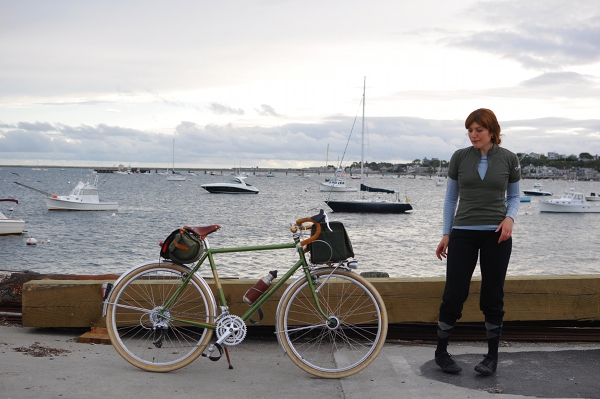
Over the time I have owned him, I feel that Graham has attained an appearance that is distinctly personalised. Looking at him reminds me of the many "firsts" I experienced on this bicycle: from learning to ride with drop bars to going downhill at 30 miles per hour, while cornering, with a full handlebar bag.
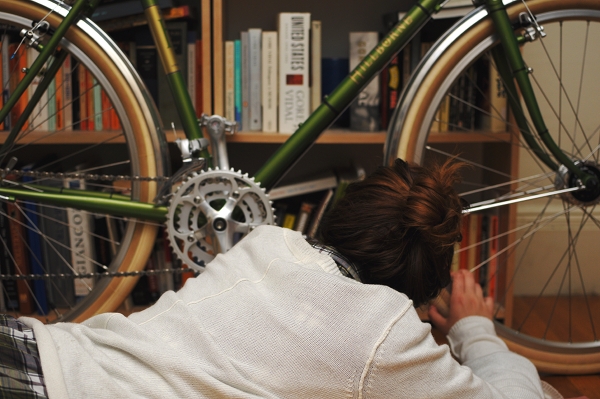
These experiences certainly did not happen all at once. After I first brought the complete bicycle home, I had a minor hysterical breakdown when the reality of owning it hit me. What on Earth would I do with such an expensive bike with drop bars?What if I wasn't able to ride it? The bike would end up standing in my livingroom as a beautiful, ridiculous testament to the gap between my imagination and my abilities.
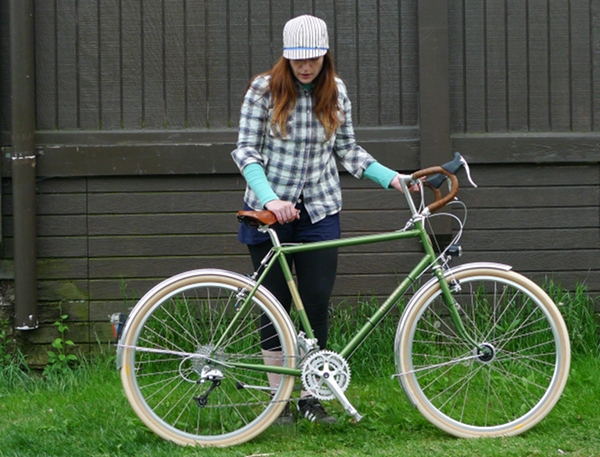
This emotional self-flogging lasted for a couple of days, but then I began to ride the bike. I took it slow and started by setting the handlebars quite high, so that I could get used to the drop bars. The
Hillborne has what I would say is a long top tube, and I have a short torso - so the degree of lean this placed me in required some adjustment on my part.
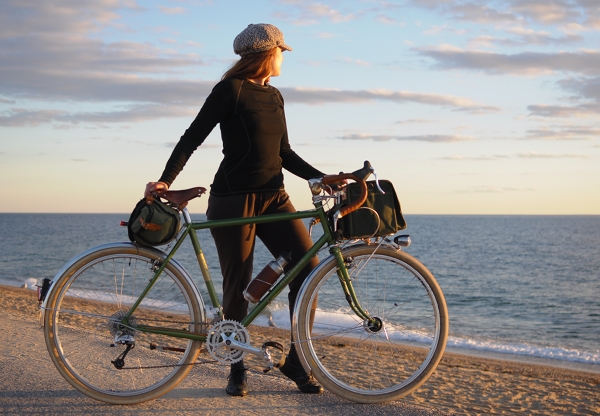
Over the course of the first month I owned the bike, I rode it almost daily and lowered the handlebars weekly - until eventually I was comfortable with them being at the level of the saddle. I would recommend this method to those who find dropbars intimidating.
I love pretty much everything about this bicycle and find it difficult to muster up any words of criticism. It may be worth noting that some dislike the slight upward slope to the top tube on the
Hillborne, but I have no problem with it. If I have to find something bad to say, then maybe it's that the paint seems to be a bit delicate - but then I am used to powdercoat, and it's just a fact that liquid paint is easier to nick. I am equally happy with my choice of components - perhaps with the exception of the
Shimano Deore rear derailleur, which I have managed to bang up pretty badly in the course of ownership. Next spring, I may replace it with the
Shimano XT "Shadow,"which seems more immune to abuse. Otherwise, everything is perfect.
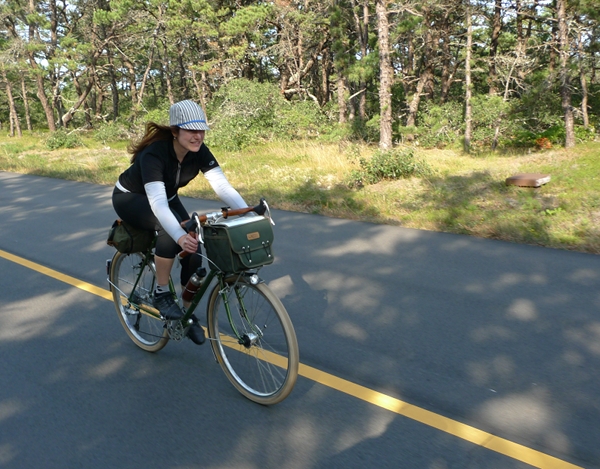
I don't know how to describe the ride quality of the
Sam Hillborne in technical terms, but in non-technical terms I feel as if I could
live on it. Nothing hurts, ever. The bicycle is miraculously cushy over bumps. There is no "toe overlap" with the front tire when turning. The seat tube angle is just right: relaxed enough to be comfortable without having to shove the saddle back on the rails, but not so relaxed as to stand in the way of "performance." I can keep up with the Co-Habitant just fine on the
Hillborne, and he is a fast cyclist. The most challenging ride I have gone on so far has been a
very hilly metric century (64 miles), and I felt great afterwards. No weight on my hands, no strain on my neck, no knee pain, just comfy cycling goodness. The bicycle seems equally stable at both high and low speeds. I can go over 20 miles per hour while feeling as if I am going 10 and I can plummet downhill while enjoying the view instead of panicking. It is also fantastic on climbs and seems to carry momentum well.
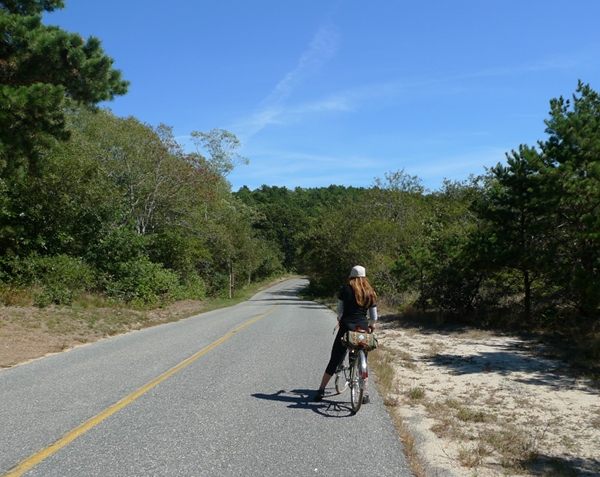
As I have mentioned at the start, I have now cycled 1,800 miles on this bike - whichmay be more than I have cycled on all my other bicycles combined. I had never imagined that I would be doing this much cycling, let alone on a roadbike. I know that it is all supposed to be about the cyclist and not about the bicycle, but I honestly do not think I would have come this far in my road cycling skills on a different bike, no way. I would even credit the
Sam Hillborne with how well I took the track bike I rode in Vienna and to the Italian racing bike I subsequently built up as a fixed gear. Once I learned the skills on the
Rivendell, I felt comfortable on other types of roadbikes as well - but I would not have been able to learn on them.

While the
Sam Hillborne was great for me as a beginner, I am nowhere close to "outgrowing" it. If anything, I feel as if I am slowly growing into it and am only starting to appreciate its full potential. Next summer I am looking forward to doing some more extensive touring and attempting more challenging hills. After all - the bike was born for them.



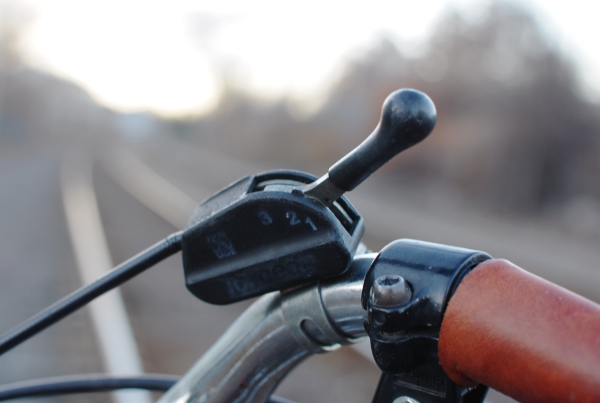 When I was first shopping for an upright bicycle with an internally geared hub, I made the natural assumption that the more gears on the hub, the better. But to my surprise, over time I changed my mind and developed a strong preference for the simple 3-speed. No more, no less: Three gears feel just right.I have been trying to make sense of why I prefer 3-speed hubs to the seemingly more advantageous 7-speeds and 8-speeds, and have a couple of ideas.
When I was first shopping for an upright bicycle with an internally geared hub, I made the natural assumption that the more gears on the hub, the better. But to my surprise, over time I changed my mind and developed a strong preference for the simple 3-speed. No more, no less: Three gears feel just right.I have been trying to make sense of why I prefer 3-speed hubs to the seemingly more advantageous 7-speeds and 8-speeds, and have a couple of ideas.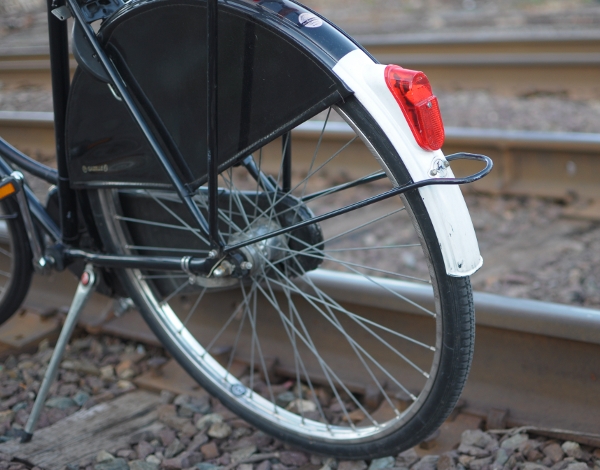 Internally geared hubs allow for a narrower range of gearing in comparison to derailleurs. And the overall range of the hub does not increase in direct proportion to the number of speeds.
Internally geared hubs allow for a narrower range of gearing in comparison to derailleurs. And the overall range of the hub does not increase in direct proportion to the number of speeds.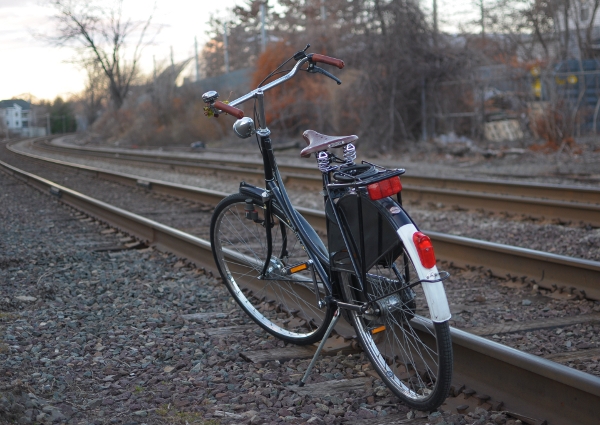 My choice of transportation bicycles plays a huge role in the usefulness of the hubs as well. In my experience, bicycles that are heavy and put the cyclist in a bolt-upright position are simply not the best choice for trips with prolonged hills, regardless of how many gears are on the hub. If I max out a 3-speed hub going uphill on a heavy upright bike, chances are that I will also max out a 7 or 8 speed hub - in which case there is no real benefit to having those additional gears. If a route is too tough for a 3-speed, then what I prefer is a lighter and more sporty bike, ideally with derailleur gearing. A bigger hub on the same heavy upright bike does not do me much good.
My choice of transportation bicycles plays a huge role in the usefulness of the hubs as well. In my experience, bicycles that are heavy and put the cyclist in a bolt-upright position are simply not the best choice for trips with prolonged hills, regardless of how many gears are on the hub. If I max out a 3-speed hub going uphill on a heavy upright bike, chances are that I will also max out a 7 or 8 speed hub - in which case there is no real benefit to having those additional gears. If a route is too tough for a 3-speed, then what I prefer is a lighter and more sporty bike, ideally with derailleur gearing. A bigger hub on the same heavy upright bike does not do me much good.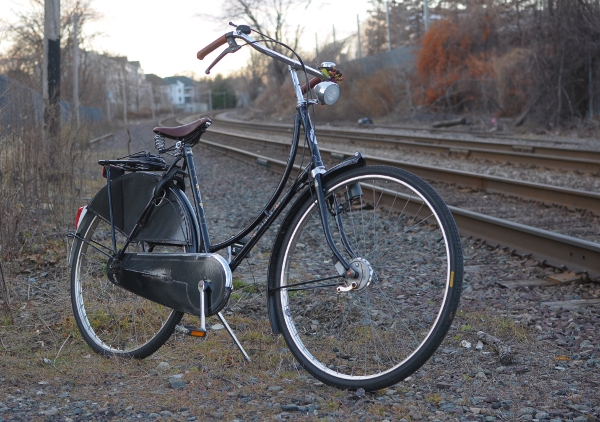 While modern bicycles are commonly available with 7 and 8 speed hubs, for me the simpler 3-speed just seems to be a better solution. Your experience may differ - but before you choose a hub with many gears, try a 3-speed and compare for yourself. You might be as surprised as I was to discover which you prefer.
While modern bicycles are commonly available with 7 and 8 speed hubs, for me the simpler 3-speed just seems to be a better solution. Your experience may differ - but before you choose a hub with many gears, try a 3-speed and compare for yourself. You might be as surprised as I was to discover which you prefer.
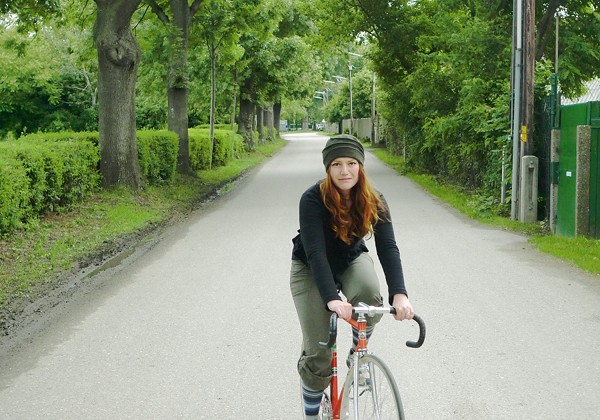 I have mentioned my wistfulness for the velodrome and my attraction to beautiful track bikes before, and, let's face it - we all thought it was pretty funny and ludicrous. But the joke has now become an unexpected reality!
I have mentioned my wistfulness for the velodrome and my attraction to beautiful track bikes before, and, let's face it - we all thought it was pretty funny and ludicrous. But the joke has now become an unexpected reality! My friend Wolfgang in Vienna suggested that I try a vintage trackbike he happens to own in my size. He transported it to the Velodrome on his cargo bike, and the idea was for me to try riding it on the adjacent paved lot. The Velodrome here is closed for the summer and the abandoned lot makes for a safe practice area. We figured that even if I managed to ride the bike for a couple of yards, it would sort of count as having been on the Velodrome grounds (right?).
My friend Wolfgang in Vienna suggested that I try a vintage trackbike he happens to own in my size. He transported it to the Velodrome on his cargo bike, and the idea was for me to try riding it on the adjacent paved lot. The Velodrome here is closed for the summer and the abandoned lot makes for a safe practice area. We figured that even if I managed to ride the bike for a couple of yards, it would sort of count as having been on the Velodrome grounds (right?). This bicycle is pretty special and once belonged to professional Austrian racer Kurt Schneider, but that is a topic for its own post. The size and fit were just right for me, really perfect. Having ridden my
This bicycle is pretty special and once belonged to professional Austrian racer Kurt Schneider, but that is a topic for its own post. The size and fit were just right for me, really perfect. Having ridden my 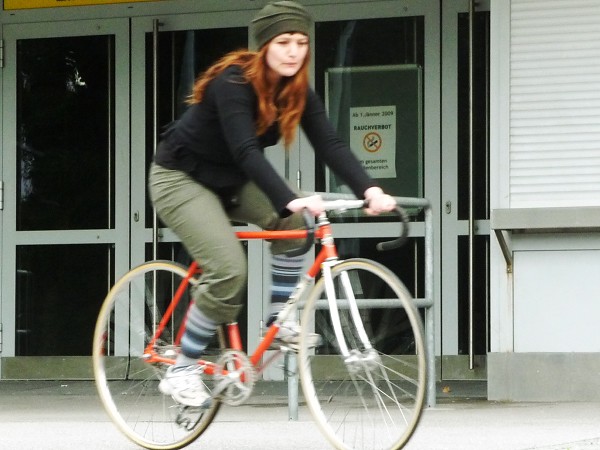 Well, apparently I survived. And what I thought would be, at best, a careful circling around the Velodrome lot, turned into an ecstatic 7-mile ride on paths and back roads on the outskirts of Vienna. Here are my impressions, from the point of view of someone who has never ridden such a bicycle before:
Well, apparently I survived. And what I thought would be, at best, a careful circling around the Velodrome lot, turned into an ecstatic 7-mile ride on paths and back roads on the outskirts of Vienna. Here are my impressions, from the point of view of someone who has never ridden such a bicycle before: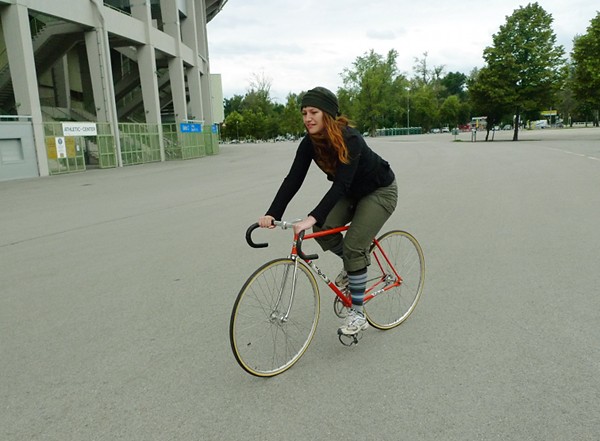 . In general, I feel that the idea of "not being able to coast" is misleading, in that it suggests that the fixed gear cyclist is hard at work the entire time, always pedaling. That is not so, because the time you'd spend coasting on a regular bike, you still spend relaxing your legs on a fixed gear. Effort-wise it is no more strenuous than coasting, only the pedals are rotating your legs for you. Just relax and let it happen.
. In general, I feel that the idea of "not being able to coast" is misleading, in that it suggests that the fixed gear cyclist is hard at work the entire time, always pedaling. That is not so, because the time you'd spend coasting on a regular bike, you still spend relaxing your legs on a fixed gear. Effort-wise it is no more strenuous than coasting, only the pedals are rotating your legs for you. Just relax and let it happen.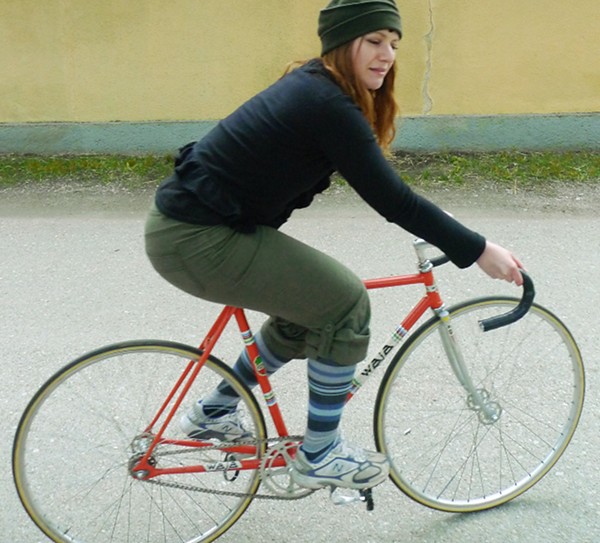 . While I do not advocate riding a brakeless trackbike on the street, I found that the stopping power was not much worse than when riding a vintage roadster with rod brakes. You just need to be aware of your speed, your surroundings, and plan your stops accordingly. I went slowly, and did not have trouble stopping when I needed to.
. While I do not advocate riding a brakeless trackbike on the street, I found that the stopping power was not much worse than when riding a vintage roadster with rod brakes. You just need to be aware of your speed, your surroundings, and plan your stops accordingly. I went slowly, and did not have trouble stopping when I needed to.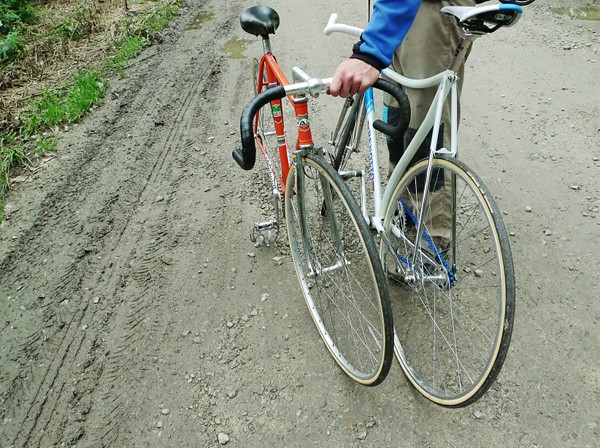 . I expected a bike with "track geometry" to be uncomfortable to ride. This bicycle was extremely comfortable, but I am not sure to what extent it is bike-specific - maybe it is just extremely well built. Even the 23mm tubular tires felt fine - including off road!
. I expected a bike with "track geometry" to be uncomfortable to ride. This bicycle was extremely comfortable, but I am not sure to what extent it is bike-specific - maybe it is just extremely well built. Even the 23mm tubular tires felt fine - including off road! I am not sure whether my feedback is typical or not. But that was my experience, and I absolutely loved it. It was especially wonderful to actually go
I am not sure whether my feedback is typical or not. But that was my experience, and I absolutely loved it. It was especially wonderful to actually go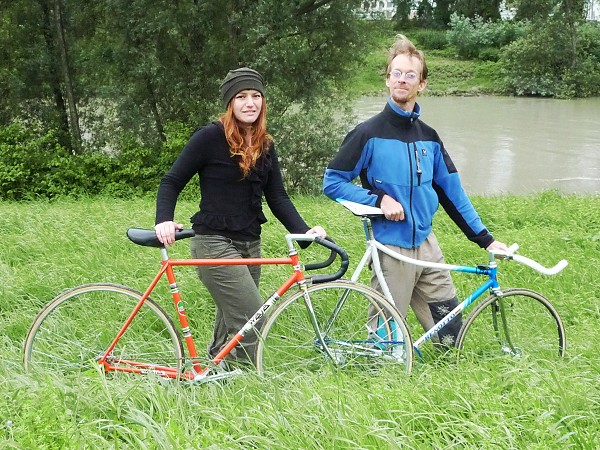 A big Thank You to Wolfgang again for this experience. (And in case you are wondering, he is riding a Benotto time trial bike.)
A big Thank You to Wolfgang again for this experience. (And in case you are wondering, he is riding a Benotto time trial bike.)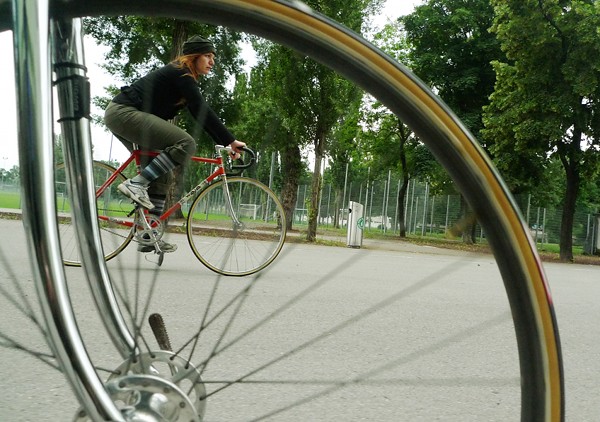 I think that the popularity of fixed gear culture today has given us a lot of misconceptions about what riding a track bike is actually like. It was completely different from what I had expected, it wasn't difficult, and most importantly, it was enjoyable. The trackbike now (temporarily) lives with me, and I have been practicing riding it after work on the Danube Canal bike path and in the Prater park.
I think that the popularity of fixed gear culture today has given us a lot of misconceptions about what riding a track bike is actually like. It was completely different from what I had expected, it wasn't difficult, and most importantly, it was enjoyable. The trackbike now (temporarily) lives with me, and I have been practicing riding it after work on the Danube Canal bike path and in the Prater park.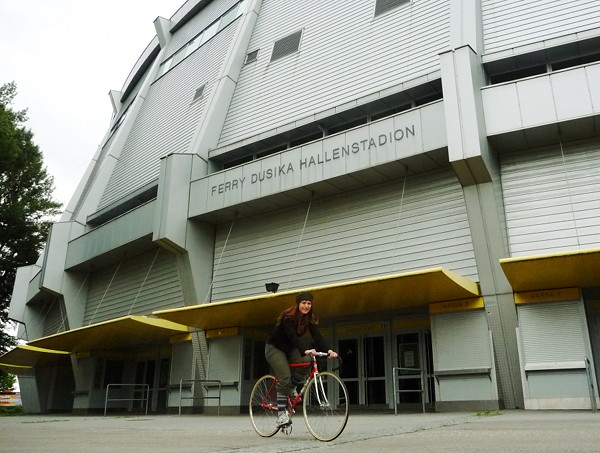 Could the crazy dream of the velodrome be not so crazy after all?
Could the crazy dream of the velodrome be not so crazy after all?








 Get ready, get set...the climbing ranger season has begun!
Get ready, get set...the climbing ranger season has begun!  With the dark clouds came strong winds, rain and snow.
With the dark clouds came strong winds, rain and snow. A close-up view of the mountains beneath those big gray clouds. This particular storm passed by quickly. But other storms and more wind came again during the night. It was a very restless night!
A close-up view of the mountains beneath those big gray clouds. This particular storm passed by quickly. But other storms and more wind came again during the night. It was a very restless night! In the morning we were greeted with sunshine, blue skies, and somewhat cooler temperatures. As I headed a few miles south toward Willcox and Chiricahua, I wondered what more Mother Nature could bring my way.
In the morning we were greeted with sunshine, blue skies, and somewhat cooler temperatures. As I headed a few miles south toward Willcox and Chiricahua, I wondered what more Mother Nature could bring my way.
 10/26 near Bacon Hollow Overlook
10/26 near Bacon Hollow Overlook 10/26 Moorman's River Overlook
10/26 Moorman's River Overlook 10/28 Fog Rising at Fisher's Gap Overlook
10/28 Fog Rising at Fisher's Gap Overlook 10/28 from Hawksbill Summit
10/28 from Hawksbill Summit 10/28 Crescent Rock Overlook
10/28 Crescent Rock Overlook 10/29 Gimlet Ridge Overlook
10/29 Gimlet Ridge Overlook
 What had my heart singing with glee though was the pool area. There is a fish shaped pool. There is a pool that has the baby pool built into one end so you can watch your little one play while being in the deeper end yourself. There is a splash zone. And there is my all time favorite water park feature: a lazy river. I think I spent three or four heavenly hours in this part of the campground. With an hour or so of that time including me reading a book while floating on the lazy river. I may want to stay here forever.
What had my heart singing with glee though was the pool area. There is a fish shaped pool. There is a pool that has the baby pool built into one end so you can watch your little one play while being in the deeper end yourself. There is a splash zone. And there is my all time favorite water park feature: a lazy river. I think I spent three or four heavenly hours in this part of the campground. With an hour or so of that time including me reading a book while floating on the lazy river. I may want to stay here forever.


















